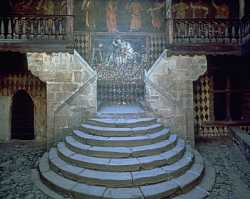TJ, I presume you've read about the iconoclastic controversy in Byzantium around the 8th-9th centuries?
So far as I understand it, the basic argument is that any image of divinity becomes itself an object of worship, rather than the divinity. I believe it's rooted in the story of the golden calf in the Old Testament, and still adhered to within Islam.
Point being, I don't think you can escape a POV thoughts from Chais because if iconoclasm is an established idea, then it already exists as a faction, and therefore sympathies will be polarised one way or another - especially according to Chais' background and plot arc.
If it *is* a new idea, then it's going to shock the audience, and therefore create a reaction.
That's a fairly minor point, but I would expect the POV to be carried. Perhaps she's tired of the general arguments? Perhaps you could summarise a couple of the pointers in her thoughts, and have the characters strike their strongest dialogue either side?
At the moment you simply show the reactions of a couple of clergy, but I think this makes the character too passive - unless there's a reason why she is an observer to this in the first place to add her own perspective.
For example, I did personally find this part of the exchange a little weak and perhaps better summarise in a POV:
Because it seems to lack the passion that both opposing characters otherwise nicely project.
I also thought some of the character dialogue attributions towards the end could be tightened up. I presume it is Todvulf who is still speaking until implicitly stated otherwise? Simply that I did have to slow my reading to double-check here, as a potential warning. Perhaps it would be better to put "Todvulf’s scowl grew darker. He limped to the marble steps, then mounted to the landing" to start his attribution, rather than start a new paragraph after it?
The use of the word "cartouche" threw me a little as I associate more with a specific graphic for a royal name, as in Ancient Egypt. Just a pointer.
However, overall, a well written piece, but I think if you bring in the character a little more, you can really add a layer of polish to the piece. Just my personal opinion, though.
So far as I understand it, the basic argument is that any image of divinity becomes itself an object of worship, rather than the divinity. I believe it's rooted in the story of the golden calf in the Old Testament, and still adhered to within Islam.
Point being, I don't think you can escape a POV thoughts from Chais because if iconoclasm is an established idea, then it already exists as a faction, and therefore sympathies will be polarised one way or another - especially according to Chais' background and plot arc.
If it *is* a new idea, then it's going to shock the audience, and therefore create a reaction.
That's a fairly minor point, but I would expect the POV to be carried. Perhaps she's tired of the general arguments? Perhaps you could summarise a couple of the pointers in her thoughts, and have the characters strike their strongest dialogue either side?
At the moment you simply show the reactions of a couple of clergy, but I think this makes the character too passive - unless there's a reason why she is an observer to this in the first place to add her own perspective.
For example, I did personally find this part of the exchange a little weak and perhaps better summarise in a POV:
“It is an implied representation of the All-High as Conqueror of the Deceiver.”
“Surely not. It is, rather, a true representation of the Advocate himself, showing his defeat of those enemies whom he did face in life, with those enemies, themselves aspects of the Deceiver, represented in allegory.”
“The Blessed Advocate bore within him the fluid of the divine, so to represent him in any barren image is to demonstrate contempt for that divinity.”
“We each bear within our souls some minute particle of that holy fluid which flows from the All-High, yet the Work enjoins us to remember the faces of our kin, lest we forget ourselves, and to carry their images with us always.”
Because it seems to lack the passion that both opposing characters otherwise nicely project.
I also thought some of the character dialogue attributions towards the end could be tightened up. I presume it is Todvulf who is still speaking until implicitly stated otherwise? Simply that I did have to slow my reading to double-check here, as a potential warning. Perhaps it would be better to put "Todvulf’s scowl grew darker. He limped to the marble steps, then mounted to the landing" to start his attribution, rather than start a new paragraph after it?
The use of the word "cartouche" threw me a little as I associate more with a specific graphic for a royal name, as in Ancient Egypt. Just a pointer.
However, overall, a well written piece, but I think if you bring in the character a little more, you can really add a layer of polish to the piece. Just my personal opinion, though.


